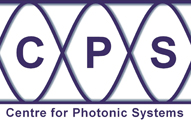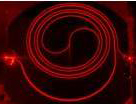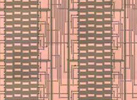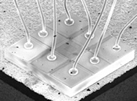| Centre for Photonic Systems Engineering Department Electrical Engineering Division |
 |
 |
 |
 |
 |
| Home | Research | People | Publications | Teaching | CDT | News | Contact |
|---|
|
CURRENT PROJECTS
PREVIOUS PROJECTS |

The INtelligent Airport: TINA Objective: Diverse applications are expected to appear in the future with complex and often varying service requirements, traffic profiles and user expectations. These will require extremely advanced adaptive computing and communication systems to provide users with mobile, secure and automatic means of conducting business. A prime application area is in international travel which continues to grow supported by a significant investment in infrastructure, such as Heathrow Terminal 5. An intelligent, adaptive, self-organising wired/wireless infrastructure is essential in this environment. It is anticipated that the considerable growth in the complexity of this infrastructure will not just be due to the proliferation of established fixed equipment such as wireless base stations, surveillance cameras, security detection equipment, display and terminal equipment. The requirements will also be for a much wider deployment of more compact portable equipment, for example, location and control equipment on a wide range of transportation equipment. Radio frequency identification (RFID) tags supported by a transparent optical-RF network can be used to sense, locate and track an array of objects including luggage, mobile assets and commercial goods and can provide additional features such as boarding pass auto-tags and access control tags. These active RFID tags will operate at low data rates, typically 64 kbit/s, but an airport environment can be expected to contain a few million of them. Mobile biometric sensors will be widely deployed in this environment providing advanced features. A range of fixed and mobile terminals will provide additional security measures such as chemical detection and analysis, while other terminals, fixed and mobile, will support passenger information and entertainment services on transit. The infrastructure will support an array of personal passenger and staff wireless media rich devices. The wired/wireless network envisaged will thus be huge and complex, supporting perhaps 10 million information sources, with an anticipated peak aggregate data rate of order 100 Gbit/s in a relatively local access environment. This is beyond the capability of any current network and research is needed to understand the principles upon which an effective system could be constructed. As this is such an ambitious and multidisciplinary project, a collaborative programme is proposed. The project has strong industrial involvement and support from Laing O'Rourke who will provide the application context, share design experience, user requirements and architectural constraints and Marconi who will contribute expertise in complex communication system design. At the outline proposal stage, we received feedback from EPSRC that they would welcome additional collaborations with those involved in airport operations. We are delighted that, in response, BAA and Boeing have agreed to become involved in the project, and within UCL links have been made to Dr Paul Brennan, who will contribute substantial knowledge of RfID, being involved in a major European project in the area. Finally we have additionally sought to involve the equipment company Motorola and the installation planning company Red-M to ensure that we can receive expert advice across all areas within the project. For further information visit http://intelligentairport.org.uk/ |
2020 Centre for Photonic Systems: information provided by webmaster@cps.cam.ac.uk |